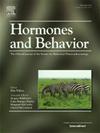脑深部光感受器在鸟类日常和季节反应调节中的作用
IF 2.4
3区 医学
Q2 BEHAVIORAL SCIENCES
引用次数: 0
摘要
鸟类表现出非凡的形态、生理和行为多样性,使它们能够适应我们星球上多样化的环境。为了达到这个目的,它们利用了不同的感觉结构。其中一个结构位于大脑深部,包含具有光色素的神经元(深部脑光感受器,DBP),可以检测环境光(光周期)的日常和季节性变化,使个体能够调整并与环境同步生理过程。这种dbp检测并将光信息传递到下丘脑-垂体-性腺轴,调节鸟类性腺的复发/消退周期和可能的日常反应。本文回顾并讨论了dbp在系统发育背景下的存在和功能的最新进展,特别关注年度生殖反应及其与日常反应的鲜为人知的关系。我们还讨论了季节性生殖调节机制的例外情况,如在机会主义鸟类(如耳鸽)中观察到的情况,其中食物供应似乎驱动性腺振荡器的活动。最后,提出了dbp向鸟类昼夜节律系统传递光周期信息的可能神经通路。本文章由计算机程序翻译,如有差异,请以英文原文为准。

Role of deep brain photoreceptors in regulation of daily and seasonal responses in birds
Birds exhibit an extraordinary morphological, physiological, and behavioral diversity that allows them to adapt to the diverse environments of our planet. To achieve this, they utilize different sensory structures. One of these structures is located in the deep brain and contains neurons with photopigments (Deep Brain Photoreceptors, DBP) that detect daily and seasonal changes in ambient light (photoperiod), allowing the individual to adjust and synchronize physiological processes with the environment. This DBPs detects and transmits light information to the hypothalamic-pituitary-gonadal axis, regulating the gonadal recrudescence/regression cycle and possibly daily responses in birds.
This work reviews and discusses the state of the art about the presence and functionality of DBPs in a phylogenetic context, with a particular focus on annual reproductive responses and their little-known relationship with daily responses. Exceptions to the seasonal reproductive regulation mechanism, as observed in opportunistic bird species such as the eared dove, where food availability appears to drive the activity of the gonadal oscillator are also discussed. Finally, the possible neural pathways through which DBPs transmit photoperiodic information to the circadian system in birds are proposed.
求助全文
通过发布文献求助,成功后即可免费获取论文全文。
去求助
来源期刊

Hormones and Behavior
医学-行为科学
CiteScore
6.70
自引率
8.60%
发文量
139
审稿时长
91 days
期刊介绍:
Hormones and Behavior publishes original research articles, reviews and special issues concerning hormone-brain-behavior relationships, broadly defined. The journal''s scope ranges from laboratory and field studies concerning neuroendocrine as well as endocrine mechanisms controlling the development or adult expression of behavior to studies concerning the environmental control and evolutionary significance of hormone-behavior relationships. The journal welcomes studies conducted on species ranging from invertebrates to mammals, including humans.
 求助内容:
求助内容: 应助结果提醒方式:
应助结果提醒方式:


